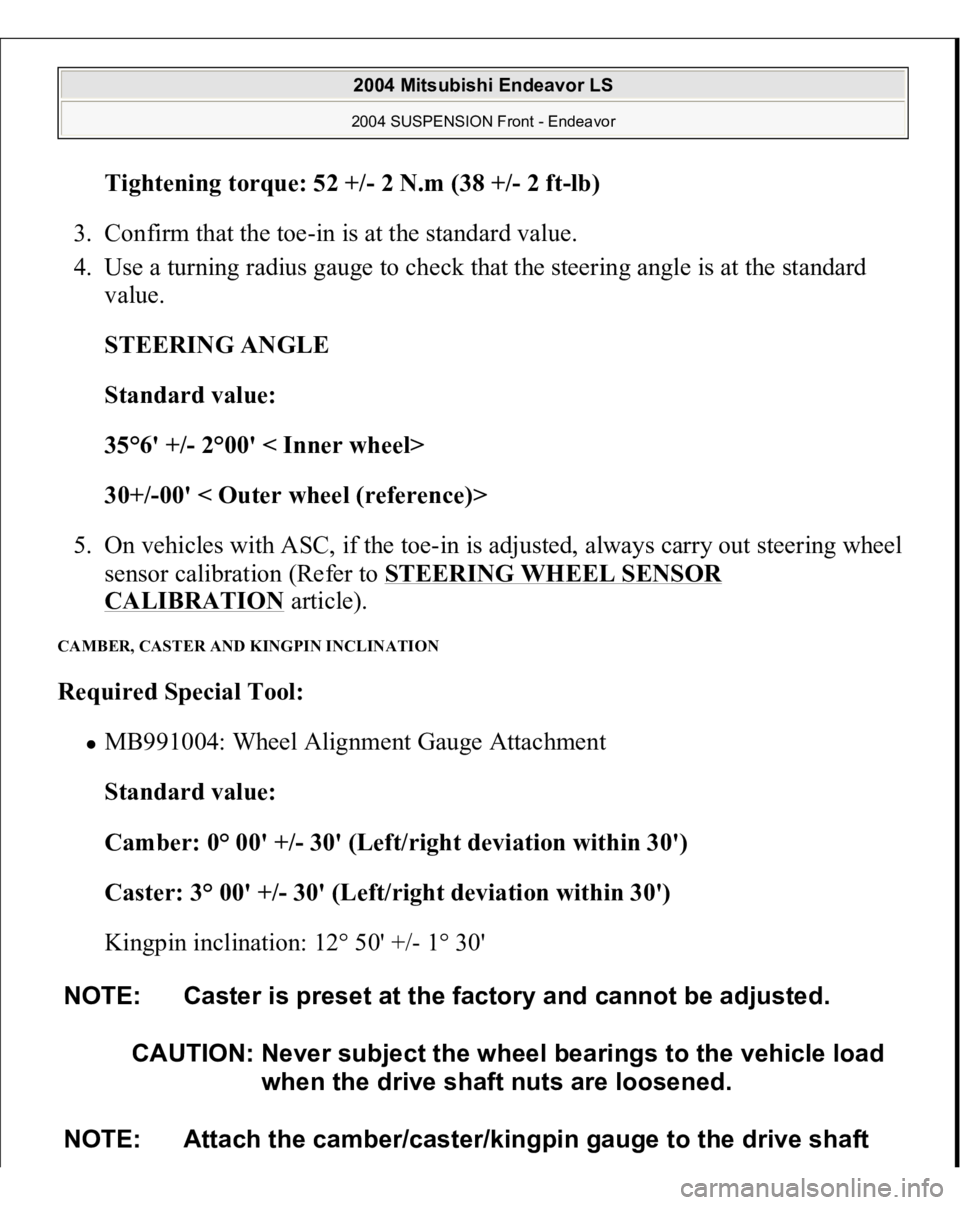Page 1524 of 3870

Mixture Check)
Courtesy of MITSUBISHI MOTOR SALES OF AMERICA.
3. Check that the basic ignition timing is within the standard value.
Standard value: 5° BTDC+/-3°
4. Start the engine and increase the engine speed to 2,500 r/min for 2 minutes.
5. Set the CO, HC tester.
6. Check the CO contents and the HC contents at idle.
Standard value:
CO contents: 0.5% or less
HC contents: 100 ppm or less
7. If the CO and HC contents do not remain inside the standard value, check the
following items:
Diagnostic output Closed-loop control (When the closed-loop control is carried out normally, the
output signal of the heated oxygen sensor changes between 0 - 400 mV and
600 - 1,000 mV at idle.) Fuel pressures Injector Ignition coil, spark plug EGR system and EGR valve leak Evaporative emission system Compression pressure
COMPRESSION PRESSURE CHECK Re
quired S
pecial Tool
:
NOTE: Replace the catalytic converter when the CO and HC
contents do not remain inside the standard value, even
though the result of the inspection is normal for all items.
2004 Mitsubishi Endeavor Limited
2004 ENGINE Engine - Endeavor
Page 1525 of 3870
MB991958: Scan Tool (MUT-III Sub Assembly)
MB991824: V.C.I. MB991827: MUT-III USB Cable MB991910: MUT-III Main Harness A
1. Before checks set the vehicle in the following condition:
Engine coolant temperature: 80 - 95°C (176 - 203°F) Lights and all accessories: OFF Transaxle: P range
2. Remove all of the ignition coils and spark plugs.
3. Disconnect the crankshaft position sensor connector.
NOTE: Vehicles for Canada, the headlight, taillight, etc. remain
lit even when the lighting switch is in "OFF" position
but this is no problem for checks.
NOTE: Doing this will prevent the engine control module from
carrying out ignition and fuel injection.
2004 Mitsubishi Endeavor Limited
2004 ENGINE Engine - Endeavor
Page 1526 of 3870
Fig. 21: Disconnecting Crankshaft Position Sensor Connector
Courtesy of MITSUBISHI MOTOR SALES OF AMERICA.
4. Cover the spark plug hole with a shop towel etc., during cranking. After the
engine has been cranked, check for foreign material adhering to the shop towel.
5. Set compression gauge to one of the spark plug holes.
WARNING:Keep your distance from the spark plug hole
when cranking. Oil, fuel, etc., may spray out
from the spark plug hole and may cause serious
injury.
2004 Mitsubishi Endeavor Limited
2004 ENGINE Engine - Endeavor
Page 1528 of 3870
malfunction is a worn or damaged piston ring and/or cylinder inner
surface.
2. If the compression does not rise after oil is added, the cause is a burnt or
defective valve seat, or pressure is leaking from the gasket.
9. Connect the crankshaft position sensor connector.
10. Install the spark plugs and ignition coils.
11. Use the scan tool MB991958 to erase the diagnostic trouble codes.
NOTE: This will erase the diagnostic trouble code resulting from
the crankshaft position sensor connector being
disconnected.
2004 Mitsubishi Endeavor Limited
2004 ENGINE Engine - Endeavor
Page 1851 of 3870
2004 DRIVELINE/AXLES
Front Axle Hub & Axle Shafts - Endeavor
FRONT AXLE HUB ASSEMBLY REMOVAL AND INSTALLATION
CAUTION:
For vehicles with ABS, do not strike the ABS
rotors installed to the BJ outer race of drive shaft
against other parts when removing or installing
the drive shaft. Otherwise the ABS rotors will be
damaged. For vehicles with ABS, be careful not to strike the
pole piece at the tip of the front ABS sensor with
tools during servicing work.
2004 Mitsubishi Endeavor LS
2004 DRIVELINE/AXLES Front Axle Hub & Axle Shafts - Endeavor
2004 Mitsubishi Endeavor LS
2004 DRIVELINE/AXLES Front Axle Hub & Axle Shafts - Endeavor
Page 1863 of 3870
Fig. 11: Measuring Wheel Bearing Axial Play
Courtesy of MITSUBISHI MOTOR SALES OF AMERICA.
DRIVE SHAFT ASSEMBLY REMOVAL AND INSTALLATION
CAUTION:
For vehicles with ABS, do not strike the ABS
rotors installed to the BJ outer race of drive shaft
against other parts when removing or installing
the drive shaft. Otherwise the ABS rotors will be
damaged. For vehicles with ABS, be careful not to strike the
pole piece at the tip of the front ABS sensor with
tools during servicing work.
2004 Mitsubishi Endeavor LS
2004 DRIVELINE/AXLES Front Axle Hub & Axle Shafts - Endeavor
Page 1945 of 3870
Fig. 4: Special Tools (2 Of 2)
Courtesy of MITSUBISHI MOTOR SALES OF AMERICA.
ON-VEHICLE SERVICE FRONT WHEEL ALIGNMENT CHECK AND ADJUSTMENT Measure wheel alignment with alignment equipment on a level surface. The front
sus
pension, steerin
g system, wheels, and tires should be serviced to normal
CAUTION: On vehicles with ASC, if the wheel alignment is
adjusted, always carry out steering wheel sensor
calibration (STEERING WHEEL SENSOR
CALIBRATION
). This is necessary because the
TCL/ASC-ECU should update the steering neutral
point.
2004 Mitsubishi Endeavor LS 2004 SUSPENSION Front - Endeavor
Page 1947 of 3870

Tightening torque: 52 +/- 2 N.m (38 +
/-2 f
t-lb)
3. Confirm that the toe-in is at the standard value.
4. Use a turning radius gauge to check that the steering angle is at the standard
value.
STEERING ANGLE
Standard value:
35°6' +/- 2°00' < Inner wheel>
30+/-00' < Outer wheel (reference)>
5. On vehicles with ASC, if the toe-in is adjusted, always carry out steering wheel
sensor calibration (Refer to STEERING WHEEL SENSOR
CALIBRATION
article).
CAMBER, CASTER AND KINGPIN INCLINATION Required Special Tool:
MB991004: Wheel Alignment Gauge Attachment
Standard value:
Camber: 0° 00' +/- 30' (Left/right deviation within 30')
Caster: 3° 00' +/- 30' (Left/right deviation within 30')
Kingpin inclination: 12° 50' +/- 1° 30'
NOTE: Caster is preset at the factory and cannot be adjusted.
CAUTION: Never subject the wheel bearings to the vehicle load
when the drive shaft nuts are loosened.
NOTE: Attach the camber/caster/kingpin gauge to the drive shaft
2004 Mitsubishi Endeavor LS 2004 SUSPENSION Front - Endeavor